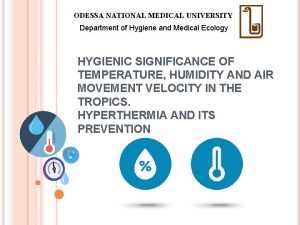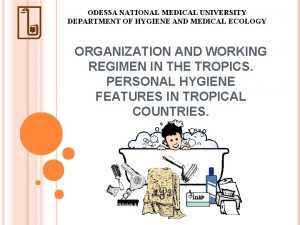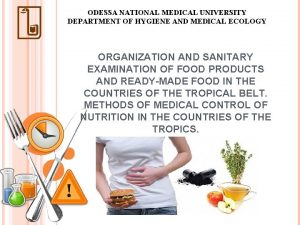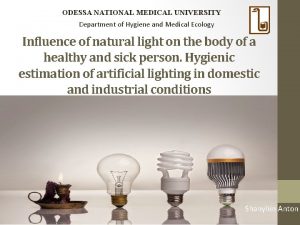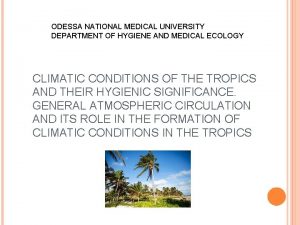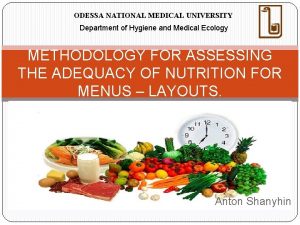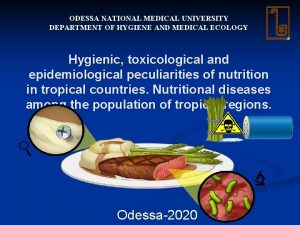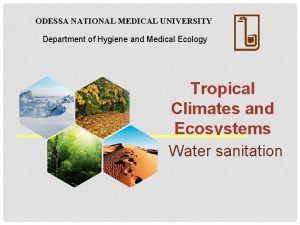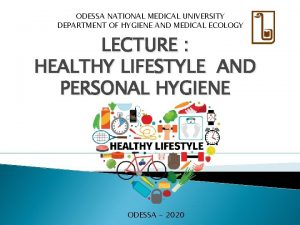ODESSA NATIONAL MEDICAL UNIVERSITY Department of Hygiene and











- Slides: 11

ODESSA NATIONAL MEDICAL UNIVERSITY Department of Hygiene and Medical Ecology Safe Drinking Water and Sanitation

Global Status Regional distribution of global population not served with improved water supply and improved sanitation Total unserved: 1. 1 billion Total unserved: 2. 4 billion (Global Water Supply and Sanitation Assessment 2000 Report: : WHO and UNICEF, 2000)

Global Coverage (Global Water Supply and Sanitation Assessment 2000 Report: : WHO and UNICEF, 2000)

Urban Explosion Rapid urbanization may bring the urban poor more ill-health (World Development Report 2003 : The World Bank, 2002)

Key Targets - WSSD Plan of Implementation (Safe Drinking Water) Halve, by the year 2015, the proportion of people without access to safe drinking water (reaffirmation of Millennium Development Goal) (Sanitation) Halve, by the year 2015, the proportion of people who do not have access to basic sanitation

Type 2 Partnerships / Initiatives (Safe Drinking Water and Sanitation) Some Examples – The Water, Sanitation and Hygiene (WASH) for all Initiative : WSSCC – Dialogue on Effective Water Governance : GWP, UNDP – Establishment of networking partnership for sharing knowledge and cooperation through the activities of the 3 rd World Water Forum: Secretariat of WWF 3 e. t. c.

Examples of Key Issues (General) • Means to achieve the target – Concrete actions • Sharing knowledge and experience • Concerted actions at all levels – Follow-up mechanism • Identification of roles of existing institutions and mechanisms • Specific role of the following WWFs

Examples of Key Issues (Safe Drinking Water) • Planning at country level to achieve the target – Ownership and governance / Promotion of political will • Providing safe drinking water supply – Full use of traditional system and site-specific technologies • Maintenance of existing systems – Rehabilitation and improved operation and maintenance of existing systems • Capacity building – Human resources and institutional building – Synergy among partners

Examples of Key Issues (Sanitation) • Expanding and improving sanitation services which should be affordable and socially and culturally acceptable Climate, Culture, Public Acceptance Water Resources, Natural Environment • Promoting safe hygiene education and practices • Develop Technical and Financial Capacity Technology Socioeconomics Keys to Sustainable Progress in Sanitation

Integrate Sanitation into Water resources Management as well as Water Pollution Prevention Humans Safe Drinking Water and Other Domestic Water Sanitation for Black / Gray Water Nature Agriculture, Industry and Other Water Uses

Good Governance and Broad Participation ・ Policy Making and Public Awareness Institutional/Financial/Technological Arrangement Technical Advisors Government Schools NGOs Mass Media Health Workers Private Sector Citizen Other Stakeholders Community Leaders
 Odessa state environmental university
Odessa state environmental university Odessa state environmental university
Odessa state environmental university North central plains region major cities
North central plains region major cities Oc tech odessa tx
Oc tech odessa tx Coding bootcamps odessa
Coding bootcamps odessa Kiev odessa
Kiev odessa Brenntag
Brenntag Jobsindice.com odessa tx
Jobsindice.com odessa tx Odessa commercial sea port
Odessa commercial sea port M.gorky donetsk national medical university
M.gorky donetsk national medical university Seoul national university history
Seoul national university history Mongolian national university of medical sciences
Mongolian national university of medical sciences












